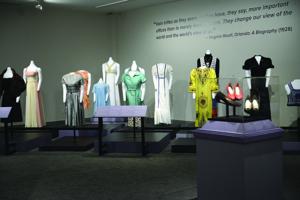Most Popular
A COFFEE DATE WITH THE SCOTTSDALE TWINS BEHIND THE FASHION CITIZEN
Meet Stephanie and Melissa Valenzuela, long-time Arizona residents and fashion enthusiasts, and, oh yeah, twins (the fraternal kind). The 24-year-old ... ...



Virginia Historical Society looks at fashion through the years in 'Looking Good'
“Our mothers at that time really didn’t wear pants, they wore dresses,” said Janet Johnson Cropp, a Fredericksburg resident since 1952, when as a child her family moved here from North Carolina.
“They just didn’t feel modest in anything but a dress,” Cropp said.
And hats. “All the women wore hats when they went out. Going to church that was the big thing, to see who had what on,” Cropp said.
A new exhibit at the Virginia Historical Society, “Looking Good: Fashion in Virginia, 1930-1970,” demonstrates what some of those hats and dresses were like.
Opening just before Christmas, the exhibit at the Richmond museum may be viewed at no cost through April in the new Susan and David Goode Gallery.
“People oftentimes don’t think of fashion as being a historical artifact to explore the identity of the age,” said Lauranett Lee, curator of the exhibit.
“Our clothing is so personal, it’s something we choose carefully as we present ourselves to the world,” Lee said. “This was even more true in the 1940s and ’50s, when so many women were much more directly involved in making fashion, not just wearing it.”

photo: beach bridesmaid dresses
During the first half of the 20th century, nearly all the clothing American women wore was produced in the United States. Between 1960 and 1990 that percentage dropped to about half. Today, all but 2 percent of the clothing we wear is made overseas.
From 1930 to 1970, textile production was the largest manufacturing employer in Virginia.
“Many of the women who were employed in the apparel industry were sewing machine operators,” Lee said. “They were not only making clothing, but wearing those clothes and creating fashion themselves. They had their own fashion sense.”
Included in the VHS exhibit is a sewing machine used by Samuel Brown, principal tailor at the Thalhimers department store in downtown Richmond.
“It’s a 1924 motorized sewing machine,” said Lee. Brown supervised a staff of tailors at Thalhimers until he retired in 1992. “He would have seen a lot of changes in fashion over that time,” Lee said.
Also included in the exhibit is a section on home sewing, with patterns women could use to make the kind of clothing they saw on movie stars.
“You see a lot of women really being creative, building on those basic patterns,” Lee said. “These were custom-made clothes that would make a statement.”
Cropp said her mother didn’t sew, but many of her friends’ mothers did. “When I was in fourth grade everybody had to have a Colonial dress for a school pageant we had,” Cropp said. “My neighbor made one for me.” Years later Cropp’s daughter used the same dress for a similar fourth grade pageant, and Cropp still has it today.
The same neighbor made a white dress for Cropp for dancing around the maypole on May Day.
Attending high school in the early ’60s, Cropp said every girl was required to take home economics and learn how to sew.
“Some girls of course were very good at it,” Cropp said. “We had to make a blouse, very unattractive, and we had to wear it to school to get our grade. Oh, my goodness, we hated that!”
She said as they matured, some of her friends made their daughters’ clothes: “Yes, for years and years. Particularly for special occasions, party dresses and that kind of thing.”
Some of those special occasions were simply to go to the city to shop, according to Lee. “It was an event,” she said. “You would go downtown, have lunch together. The Tea Room at Miller & Rhoads, for example, you would go there and watch the fashion show.”
Cropp remembers making a special trip to Richmond during her high school years. “You had to go to Montaldo’s and get a pair of Weejuns loafers,” she said. “That was the only place you could get them. That was heaven, getting those shoes!”
see more: yellow bridesmaid dresses